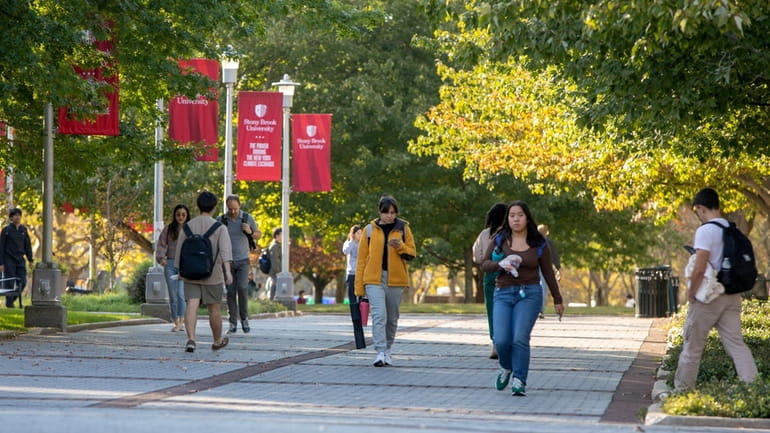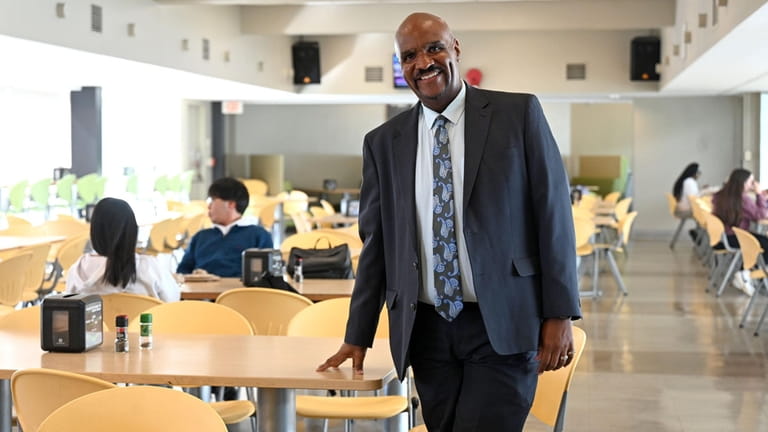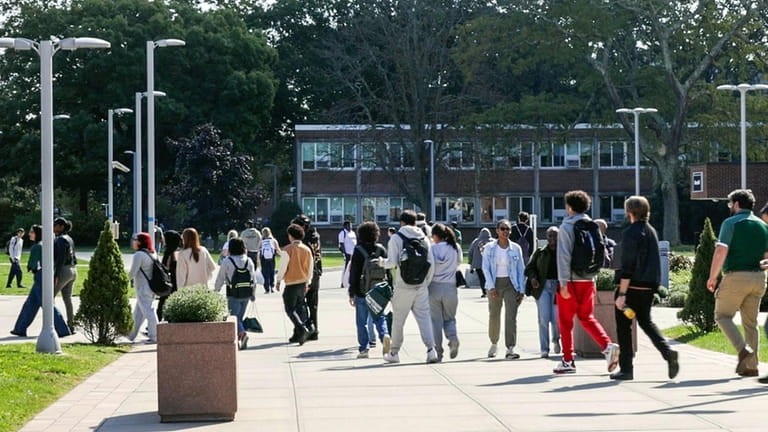Growing numbers of first-year students factor into enrollment rebound on Long Island college campuses

Students on Stony Brook University's campus on Thursday. Credit: Morgan Campbell
SUNY Old Westbury administrator Bryan Terry can see the difference on campus this semester just by watching the stream of students on their way to lunch in the cafeteria.
Large groups of laughing and engaged young people walk by his office window and fill the cafeteria with the sounds of their chatter. Not so last spring, when Terry arrived as the new vice president of enrollment management, he said.
“Last spring I walked into the cafeteria, it was like each student had their own table. Students were coming in with their headphones on, sitting by themselves listening to music, looking down at their cellphones,” he said. “This fall you see all the tables filled up. It’s really great to see.”
The sense of students coming out of their shells of pandemic isolation also is reflected in the fall enrollment numbers on campuses of Long Island universities. At Old Westbury, overall enrollment rose by almost 200 students, to 4,441 this fall, from 4,252 a year ago. Notably, first-year enrollment on most local campuses is slightly above figures from last year, when colleges began to recover from the impacts of the COVID pandemic. Overall enrollment had dropped in 2020 and 2021 after instruction shifted online for most students.
Freshman enrollment this fall is above pre-pandemic levels at schools including SUNY Old Westbury, Stony Brook University and Farmingdale State College, all colleges in the SUNY system that benefited from a free application period last fall, resulting in a surge of applications.
"On our side we’ve been heavily recruiting," said Richard Beatty, associate provost for enrollment management at Stony Brook University. "There were free application weeks, so many state schools in New York saw a marked increase in applications."
Adelphi University and New York Institute of Technology also are seeing enrollment growth, and Hofstra University — despite a decrease in first-year freshmen compared to a year ago — has rebounded to higher total enrollment levels of a decade ago.
Local colleges are seeing enrollment increases due to other factors, too.
At SUNY Old Westbury, the first-year class this fall numbers 640, only a slight increase over 616 a year ago, and the pre-pandemic fall of 2019, when 612 freshmen enrolled. But the number of students who were re-enrolling after dropping out was 16% higher this fall than last year, Terry said.
While freshman enrollment has fallen at Molloy University in the past year, this fall's total enrollment is slightly higher than last fall's thanks in part to a 31% increase in transfer students, said Linda Albanese, Molloy’s vice president of enrollment management at the Rockville Centre campus.
“This is the first time since COVID we have full residence halls and a waiting list,” Albanese said. “This year’s first-year class is the second largest in Molloy’s history. Last year when we officially became a university was our largest.”
Long Island University said final enrollment numbers wouldn't be available until next month, but it continues to increase "both in numbers and the quality of candidates that we attract to our many research-oriented experiential learning programs," said Ali Jabbour, chief communications and branding officer.
Enrollment has been in steady decline at community colleges nationally, in part due to falling numbers of high school-age Americans. Current freshman enrollment at Nassau and Suffolk community colleges is lower than pre-pandemic fall 2019, by 26% and 20%, respectively.
However, in an encouraging sign, Nassau Community College’s freshman fall enrollment is higher than a year ago, and at Suffolk County Community College, this fall’s small decline in first-time students is leading to hopes that the downturn is stabilizing, school spokesman Drew Biondo said.
Some of the increases reflect growth strategies at the universities, including at Farmingdale, which is aiming for a total enrollment of 10,000, up from 9,604 today, and at Stony Brook, which wants to grow to 30,000 students over the next decade, up from the current 25,865.
Fall enrollment at Stony Brook includes 17,549 undergraduates, slightly more than 17,509 undergraduates a year ago. Last fall, overall enrollment at Stony Brook was 25,710.
Adelphi’s vice president of enrollment management, Kristen Capezza, said current enrollment was at 131% of 2012 levels, with a 2% year-by-year growth in enrollment.
“Growth has been a focus for Adelphi, particularly as we become a more nationally known institution,” she said.
New York Institute of Technology said its higher fall enrollment was a result of more accepted students actually choosing to enroll, said Joseph Posillico, vice president for enrollment management.
“Strategically, we are close to reaching capacity and have done so in some programs. We are evaluating options to expand space and provide other opportunities for further growth," he said. NYIT will lease a redeveloped former hotel in Jericho for a new dorm to open next year, according to PX4 Development.
Not all campuses have rebounded completely, and longer-term trends may see a return to enrollment dips. Beatty, at Stony Brook University, warned, “In the next two years we’re going to see what is called the ‘enrollment cliff.’ It corresponds to the 2008 financial crisis, which saw a large dip in the birthrate, and now this is the demographic consequence.”
In 2007, the number of U.S. births rose by 3% over the prior year, to more than 4.31 million, the highest ever recorded. Between 2007 and 2008, however, the number of births fell to 4.25 million, and fell again, by about 3%, between 2008 and 2009, to 4.13 million, according to the National Institutes of Health's annual summary of vital statistics.
Even though New York State is “somewhat unique” due to large-scale migration of both immigrants and citizens moving in looking for jobs, Beatty said, “the Northeast in general is probably going to see the biggest hit nationally.”
At St. Joseph’s University Long Island, first-year enrollment last fall was about 10% lower than in fall 2019, and this fall it was expected to be slightly lower than last year, said spokesman Jessica McAleer, adding, however, that the number of transfer students have increased. Next Friday, the university will cut the ribbon on a new $17 million student center, the first new construction on the Patchogue campus in 18 years.
Nationally, recent figures show that college enrollment is still down despite signs of post-pandemic recovery. According to the National Student Clearinghouse, overall, undergraduate enrollment was 15% lower in fall 2021 than in fall 2010, with over 40% of the decline occurring during the pandemic.
While data for fall 2023 is not yet available nationally, the National Center for Education Statistics found that declines had begun to stabilize last fall, with the South and West doing better than the Northeast and Midwest.
Freshman enrollment increased by about 97,000, or 4.3%, last fall compared to the previous fall, according to the Clearinghouse data, which noted, however, that freshman enrollment was still lower by 150,000 than in pre-pandemic fall 2019.
SUNY Old Westbury administrator Bryan Terry can see the difference on campus this semester just by watching the stream of students on their way to lunch in the cafeteria.
Large groups of laughing and engaged young people walk by his office window and fill the cafeteria with the sounds of their chatter. Not so last spring, when Terry arrived as the new vice president of enrollment management, he said.
“Last spring I walked into the cafeteria, it was like each student had their own table. Students were coming in with their headphones on, sitting by themselves listening to music, looking down at their cellphones,” he said. “This fall you see all the tables filled up. It’s really great to see.”

Bryan Terry, SUNY Old Westbury's vice president of enrollment management, has noticed a busier campus. Credit: Danielle Silverman
The sense of students coming out of their shells of pandemic isolation also is reflected in the fall enrollment numbers on campuses of Long Island universities. At Old Westbury, overall enrollment rose by almost 200 students, to 4,441 this fall, from 4,252 a year ago. Notably, first-year enrollment on most local campuses is slightly above figures from last year, when colleges began to recover from the impacts of the COVID pandemic. Overall enrollment had dropped in 2020 and 2021 after instruction shifted online for most students.
WHAT TO KNOW
- The sense of students coming out of their shells of pandemic isolation is reflected in the fall enrollment numbers on campuses of Long Island universities.
- Notably, first-year enrollment on most local campuses is slightly above figures from last year, when colleges began to recover from the impacts of the COVID pandemic. Other factors, like an influx of transfer students, have led to enrollment increases.
- Not all campuses have rebounded completely, however. Community colleges everywhere face a tough road, and longer-term trends may see a return to enrollment dips.
Freshman enrollment this fall is above pre-pandemic levels at schools including SUNY Old Westbury, Stony Brook University and Farmingdale State College, all colleges in the SUNY system that benefited from a free application period last fall, resulting in a surge of applications.
"On our side we’ve been heavily recruiting," said Richard Beatty, associate provost for enrollment management at Stony Brook University. "There were free application weeks, so many state schools in New York saw a marked increase in applications."
Adelphi University and New York Institute of Technology also are seeing enrollment growth, and Hofstra University — despite a decrease in first-year freshmen compared to a year ago — has rebounded to higher total enrollment levels of a decade ago.
Local colleges are seeing enrollment increases due to other factors, too.
At SUNY Old Westbury, the first-year class this fall numbers 640, only a slight increase over 616 a year ago, and the pre-pandemic fall of 2019, when 612 freshmen enrolled. But the number of students who were re-enrolling after dropping out was 16% higher this fall than last year, Terry said.
While freshman enrollment has fallen at Molloy University in the past year, this fall's total enrollment is slightly higher than last fall's thanks in part to a 31% increase in transfer students, said Linda Albanese, Molloy’s vice president of enrollment management at the Rockville Centre campus.
“This is the first time since COVID we have full residence halls and a waiting list,” Albanese said. “This year’s first-year class is the second largest in Molloy’s history. Last year when we officially became a university was our largest.”
Long Island University said final enrollment numbers wouldn't be available until next month, but it continues to increase "both in numbers and the quality of candidates that we attract to our many research-oriented experiential learning programs," said Ali Jabbour, chief communications and branding officer.
Community colleges hit hard
Enrollment has been in steady decline at community colleges nationally, in part due to falling numbers of high school-age Americans. Current freshman enrollment at Nassau and Suffolk community colleges is lower than pre-pandemic fall 2019, by 26% and 20%, respectively.
However, in an encouraging sign, Nassau Community College’s freshman fall enrollment is higher than a year ago, and at Suffolk County Community College, this fall’s small decline in first-time students is leading to hopes that the downturn is stabilizing, school spokesman Drew Biondo said.
Some of the increases reflect growth strategies at the universities, including at Farmingdale, which is aiming for a total enrollment of 10,000, up from 9,604 today, and at Stony Brook, which wants to grow to 30,000 students over the next decade, up from the current 25,865.
Fall enrollment at Stony Brook includes 17,549 undergraduates, slightly more than 17,509 undergraduates a year ago. Last fall, overall enrollment at Stony Brook was 25,710.

Students on the green behind the Campus Center at Farmingdale State College on Thursday. Freshman enrollment this fall there and at other Long Island SUNYs is above pre-pandemic levels. Credit: Debbie Egan-Chin
Adelphi’s vice president of enrollment management, Kristen Capezza, said current enrollment was at 131% of 2012 levels, with a 2% year-by-year growth in enrollment.
“Growth has been a focus for Adelphi, particularly as we become a more nationally known institution,” she said.
New York Institute of Technology said its higher fall enrollment was a result of more accepted students actually choosing to enroll, said Joseph Posillico, vice president for enrollment management.
“Strategically, we are close to reaching capacity and have done so in some programs. We are evaluating options to expand space and provide other opportunities for further growth," he said. NYIT will lease a redeveloped former hotel in Jericho for a new dorm to open next year, according to PX4 Development.
Hurdles to recovery
Not all campuses have rebounded completely, and longer-term trends may see a return to enrollment dips. Beatty, at Stony Brook University, warned, “In the next two years we’re going to see what is called the ‘enrollment cliff.’ It corresponds to the 2008 financial crisis, which saw a large dip in the birthrate, and now this is the demographic consequence.”
In 2007, the number of U.S. births rose by 3% over the prior year, to more than 4.31 million, the highest ever recorded. Between 2007 and 2008, however, the number of births fell to 4.25 million, and fell again, by about 3%, between 2008 and 2009, to 4.13 million, according to the National Institutes of Health's annual summary of vital statistics.
Even though New York State is “somewhat unique” due to large-scale migration of both immigrants and citizens moving in looking for jobs, Beatty said, “the Northeast in general is probably going to see the biggest hit nationally.”
At St. Joseph’s University Long Island, first-year enrollment last fall was about 10% lower than in fall 2019, and this fall it was expected to be slightly lower than last year, said spokesman Jessica McAleer, adding, however, that the number of transfer students have increased. Next Friday, the university will cut the ribbon on a new $17 million student center, the first new construction on the Patchogue campus in 18 years.
Nationally, recent figures show that college enrollment is still down despite signs of post-pandemic recovery. According to the National Student Clearinghouse, overall, undergraduate enrollment was 15% lower in fall 2021 than in fall 2010, with over 40% of the decline occurring during the pandemic.
While data for fall 2023 is not yet available nationally, the National Center for Education Statistics found that declines had begun to stabilize last fall, with the South and West doing better than the Northeast and Midwest.
Freshman enrollment increased by about 97,000, or 4.3%, last fall compared to the previous fall, according to the Clearinghouse data, which noted, however, that freshman enrollment was still lower by 150,000 than in pre-pandemic fall 2019.

